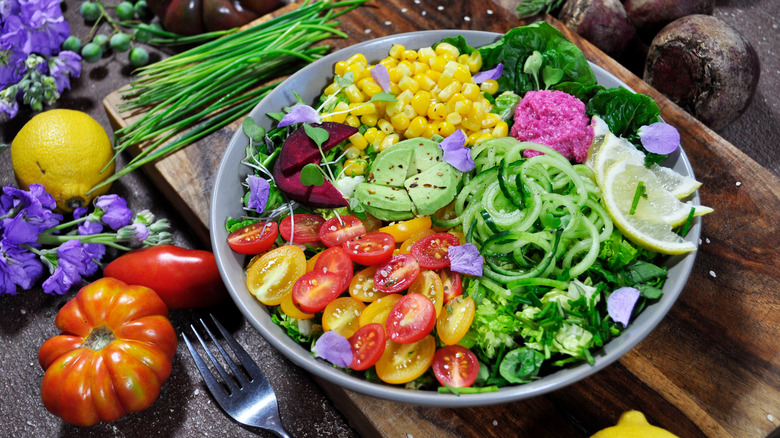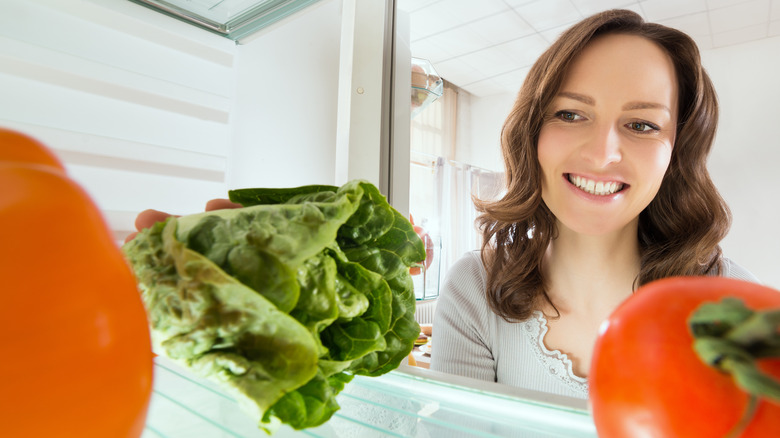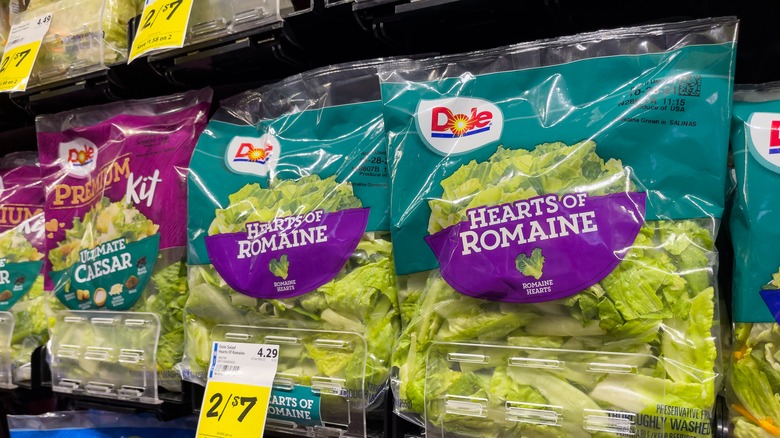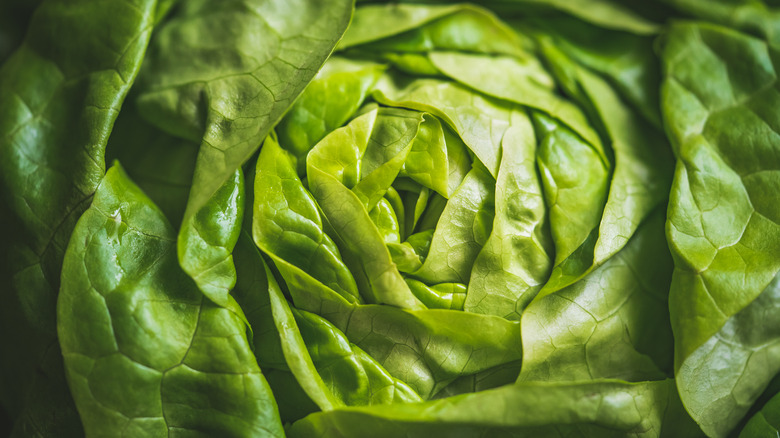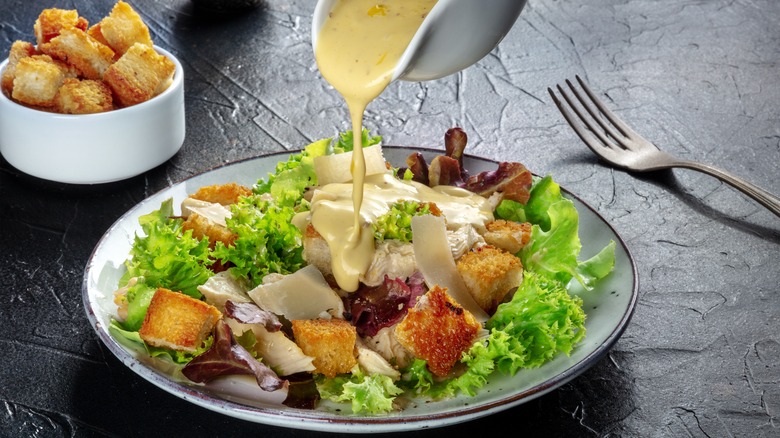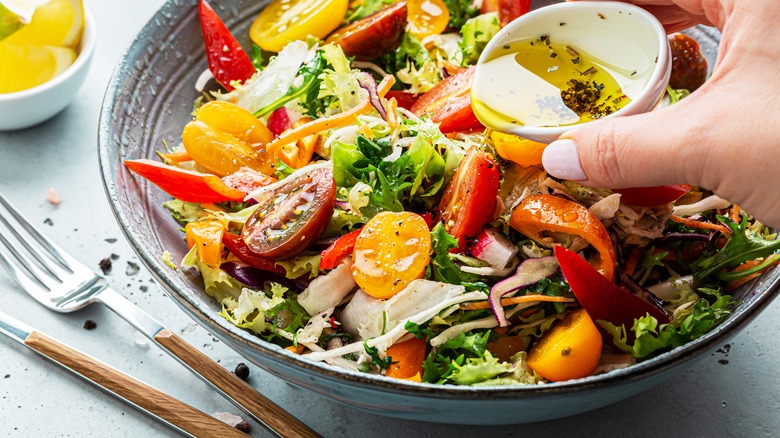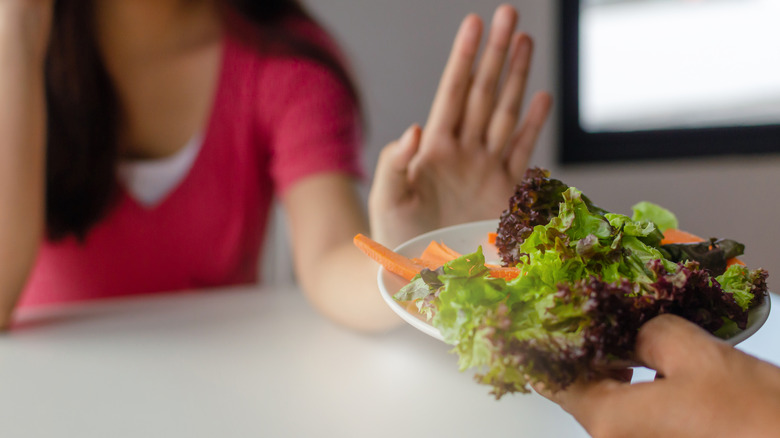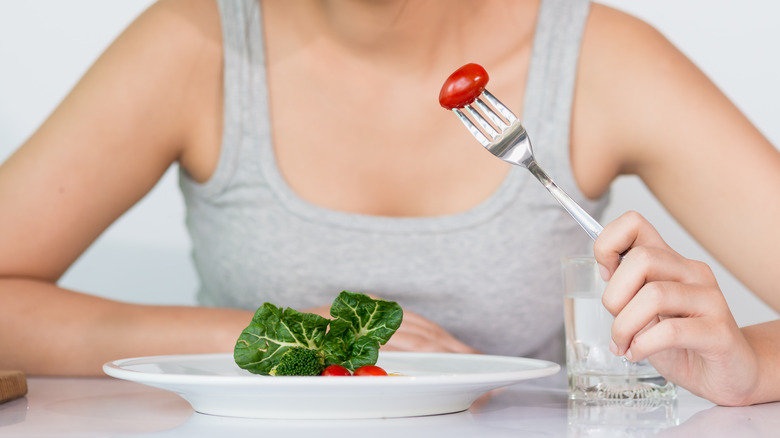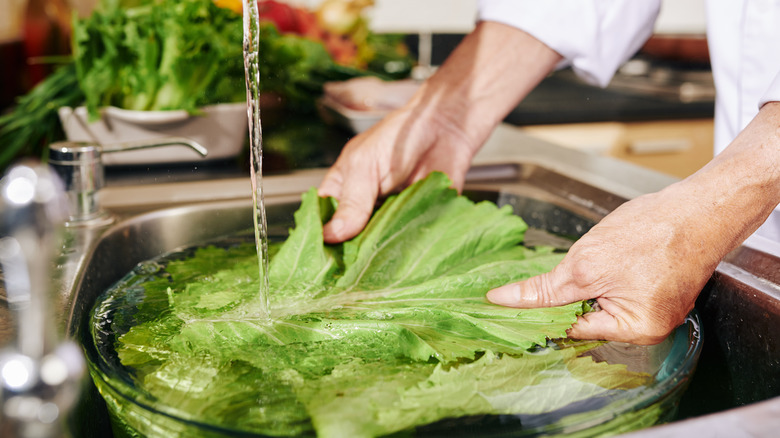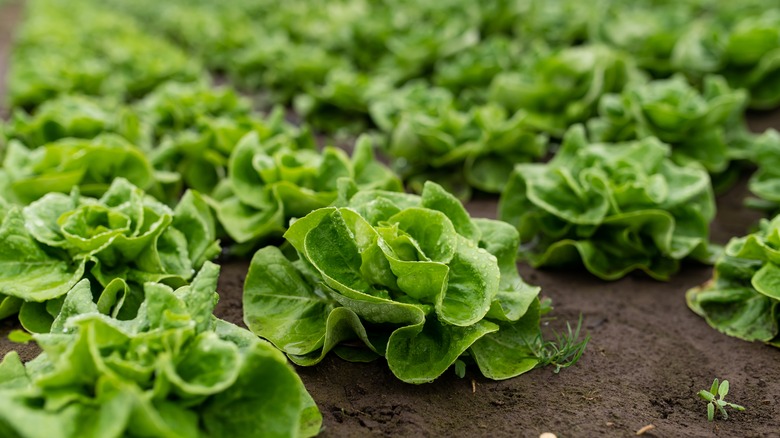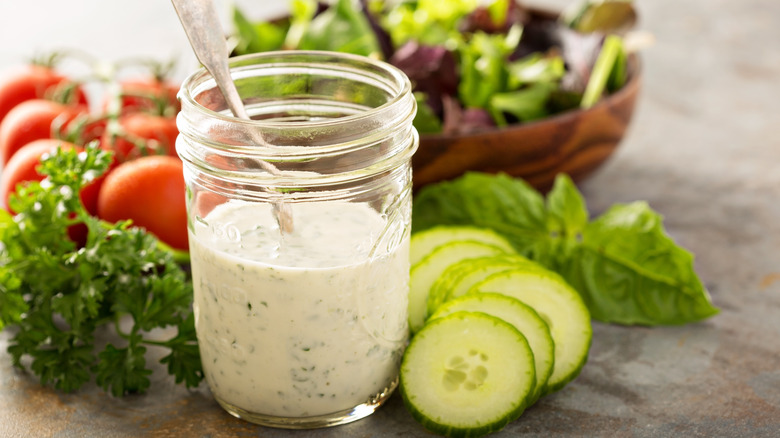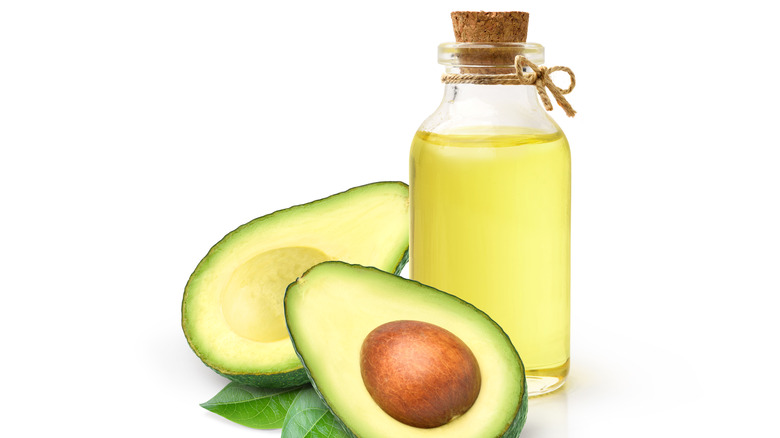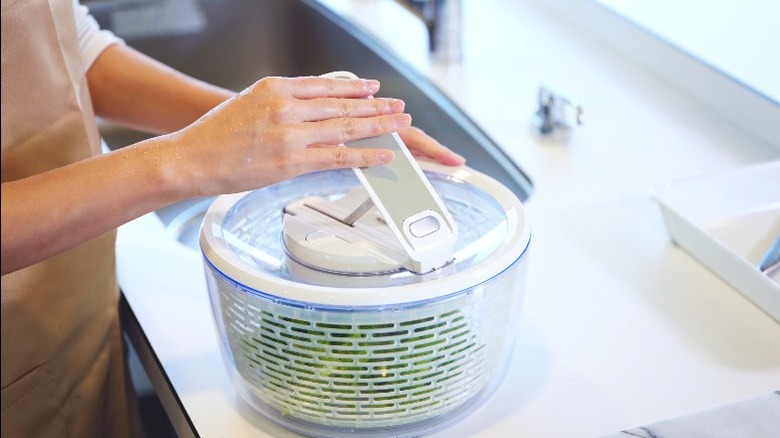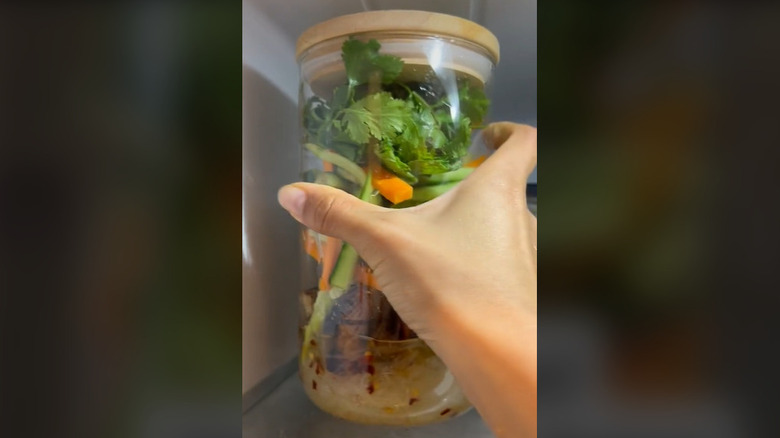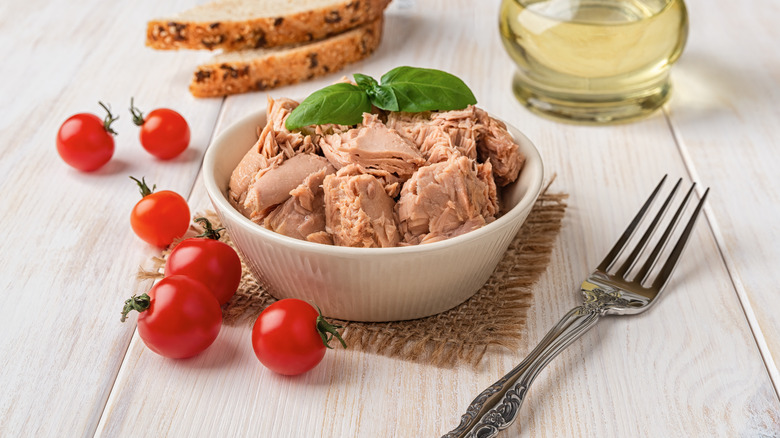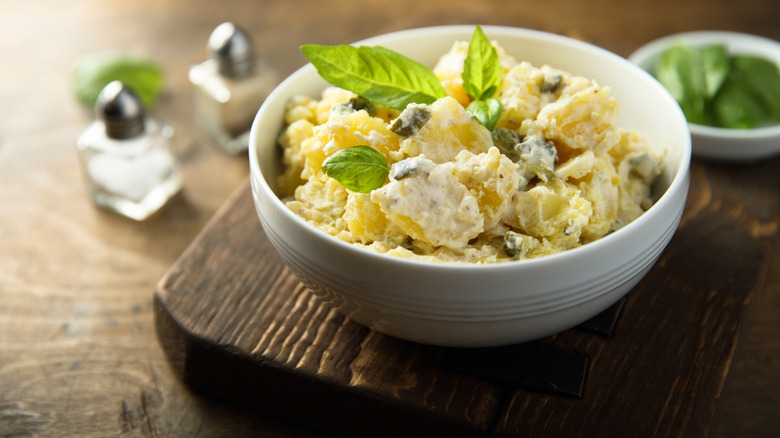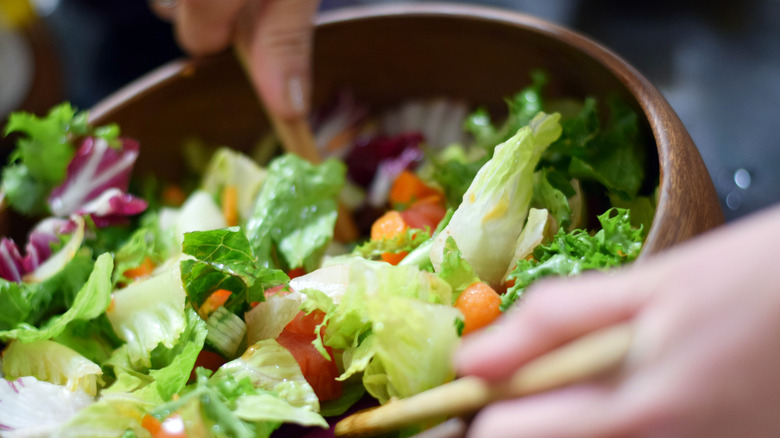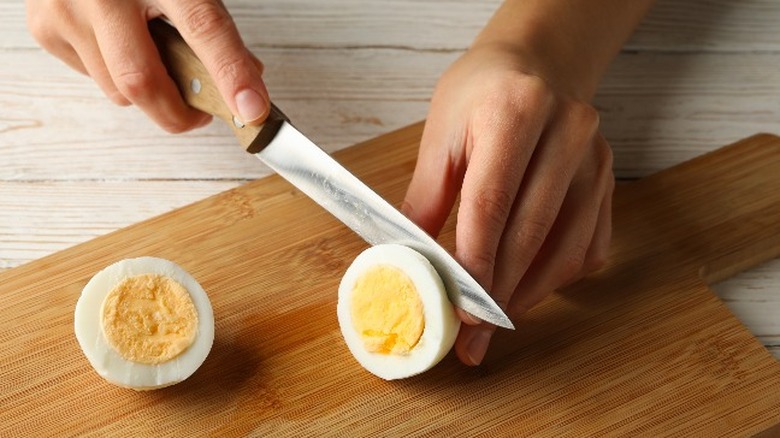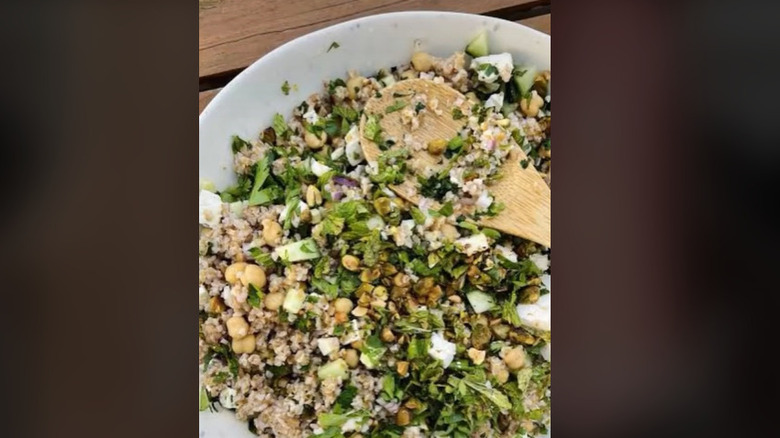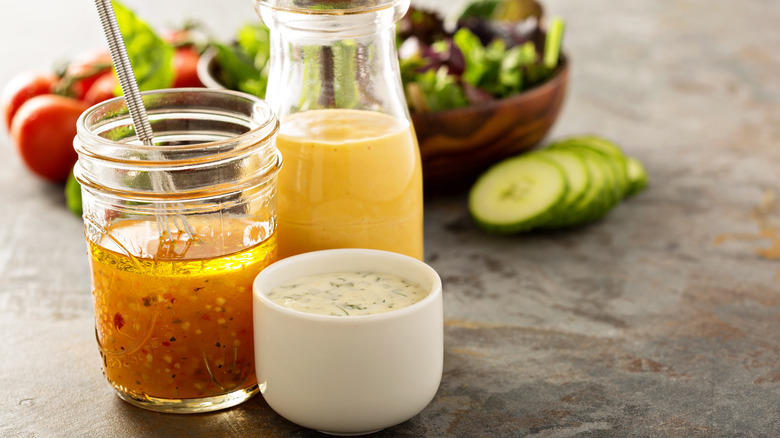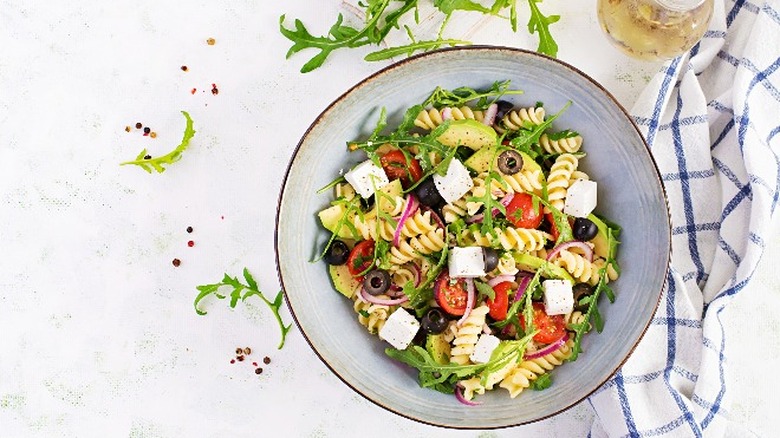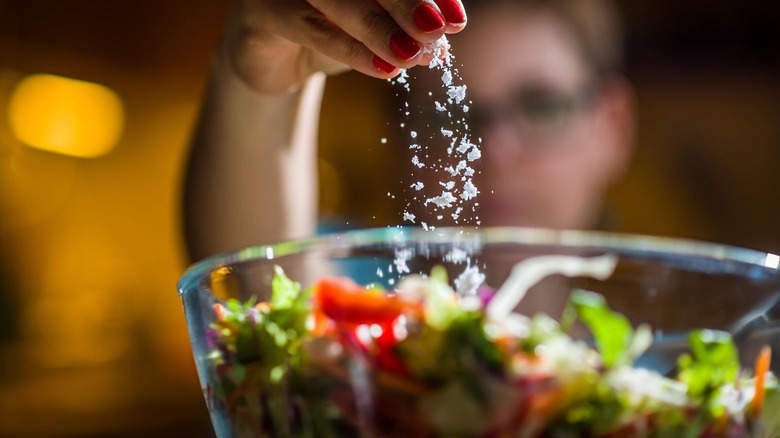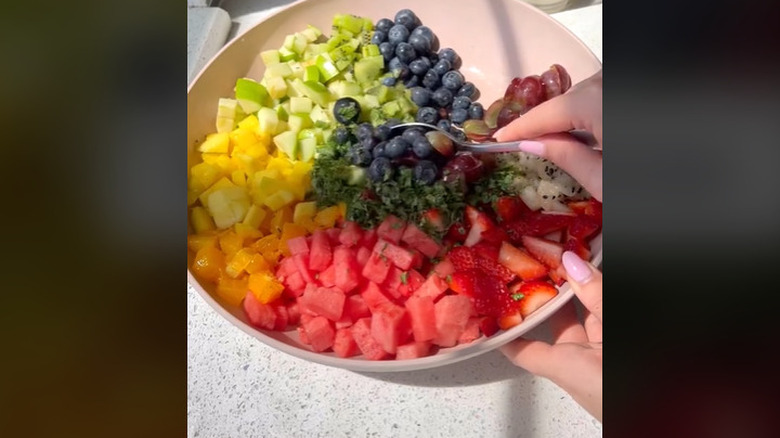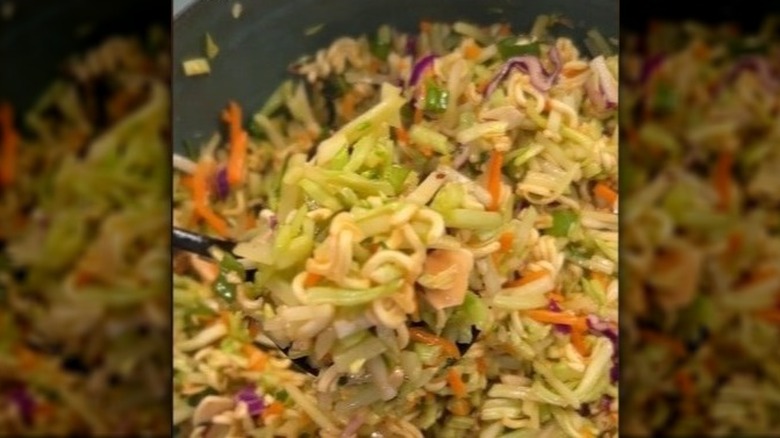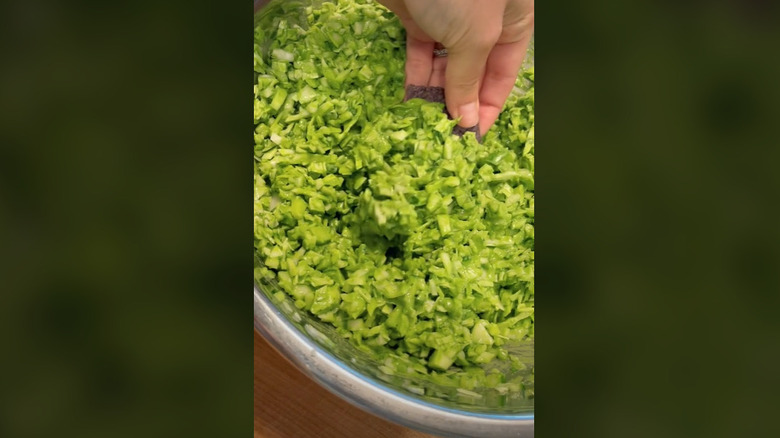Mistakes Everyone Makes When Making Salad
Once you explore the spectacular world of salads, a whole universe of versatile recipes opens up to you. The flavor combinations are endless, with rainbow-inspired bowls of goodness and stunning dressings that transform humble lettuce leaves. Enjoy making a simple salad such as mixed greens, or a classic like a niçoise salad. Did you know that Waldorf salad is named after the eponymous Waldorf-Astoria Hotel in New York City? There the mix of apples, celery, and mayonnaise was first served at the end of the 19th century, and walnuts were added a few decades later (via Taste Atlas). You can eat salads hot or cold, with ingredients that are raw or cooked. The Beverly Hills Hotel in LA serves the McCarthy signature salad, named after regular guest Neil McCarthy, who requested a chicken, bacon, egg, and veggie salad (via Citizen Femme).
Keep it simple or throw culinary caution to the wind by tossing together myriad ingredients. Salads are perfect as an appetizer, side, or an entrée. While they are often a healthy dish, they can also be a tasty indulgence. Studies suggest that eating veggie-based meals has a positive impact on the quality of your diet and also higher nutrient intake (via Science Direct). And while recipes may be simple, there's definitely an art to making a salad. A lot can go wrong, and so your first course is a serving of mistakes everyone makes when making salad — and how to avoid them.
Serving lettuce that is turning brown
There are certain vegetables and fruit that soon start to change from a vibrant green to a motley-looking brown once they're cut. Think apples, avocados, and definitely lettuce. It wouldn't be so bad if this discoloration didn't happen so quickly. It means you're a bit limited as to how far in advance you can prepare a salad before serving. After all, who wants to enjoy a forkful of brown lettuce? That would be nobody. First off, it doesn't mean your lettuce was bad because it's changed color so quickly. The science bit is that when you cut into the leaves when you're making your salad, the cells are damaged. This means that a protein mixes with an enzyme that speeds up oxidization, resulting in pigmentation (via McGill).
If your lettuce is brown before you cut into it, then that's also a result of this reaction and is due to aging. In other words, your lettuce is not at its best. While some advocate tearing the leaves rather than using a knife, because there's less rupture of the cells, the solution is to not make your salad too far in advance. Also, storing your lettuce in the right way helps too and this means keeping it in the fridge, either wrapped up or in a sealed box. Keep lettuces away from produce that releases ethylene and accelerates browning, like apples and pears (via LeafTV).
Not stopping bagged leaves going bad so quickly
If you find a bag of salad leaves more convenient than rinsing and chopping up a whole head of lettuce, then that's your prerogative. Often these bags contain a mix of different leaves, which saves you from having to buy several different types of lettuce. Anyone who buys salad in a bag will have experienced reaching in there and finding a soggy mush of leaves that have definitely gone beyond their worst to inedible. Bagged lettuce is not so convenient if you have to throw it away. The good news is that there's a simple tip to prevent this, and you start by opening the bag of salad as soon as you get home from the store (via Mirror).
One cause of mulchy leaves can be too much moisture. So open the salad bag before you put it in the fridge, and place a kitchen towel on the top. This'll absorb any excess moisture and give you an extra day or so on your leaves (as long as that's within the use-by date, of course). You can also wrap a damp kitchen towel around a whole lettuce head if you decide to ditch buying bags — which could be more environmentally friendly, too. This serves the same purpose, while also ensuring that not too much moisture is taken out and the right level of humidity keeps leaves looking good (via LeafTV).
Dehydrating lettuce so it is limp
If you imagine a wonderful salad, even a basic green one, you probably have a picture of crisp, buoyant leaves that add volume, texture, and taste. What you no doubt don't envision are leaves that have wilted and can't stand up alone, never mind with other ingredients. If your lettuce is left to dry out then the leaves will inevitably wilt, and you won't be able to serve them in a salad no matter how dressed up they are. Discard them when they need to be thrown out. But if they're not too far gone, you can hydrate them so that they're edible again. Cook's Illustrated looks at the best way to turn limp lettuce into a salad-worthy mainstay once more.
Next time you've got a bunch of lettuce leaves that look like they need revitalizing, pop them in some ice water. Leave for half an hour and be amazed at how revived they look. The water replenishes the dried-out cells with moisture. Because acids can make these cells open up even more, there's a school of culinary thought that suggests adding vinegar into the water will help. However, this could leave a strong aftertaste, and the acid in, say, cider vinegar is reported to not be acidic enough to make any noticeable difference in terms of hydration (via Cook's Illustrated). Therefore, stick with cold water. You can still use vinegar by making a tangy dressing instead.
Adding croutons that are soft
If you love crispy crouton bites, you know they're wonderful in a simple Caesar salad – unless they're soft. To avoid this culinary crime, Oven Via suggests toasting bread squares with olive oil, melted butter, and some seasonings. Once cooked, keep them away from your salad leaves, and don't store them in the fridge. Freeze them in a sealed bag before thawing and heating them back up in an oven. Or keep them in an airtight container at room temperature for up to a couple of weeks. They're at their best and crunchiest for the first two days. To retain their crispiness, throw croutons on the top of your salad at the last minute just before serving.
It may be that you decide to forgo adding croutons to your salad. After all, these delicious little cubes of crunchy carbs add calories and don't bring much to a salad in terms of big nutritional benefits. It's a mistake to think a salad is the type of food you only eat if you're trying to cut down on certain foods, but if you want to add some crunch, you have options. Walnuts are a good alternative, as are flax seeds (via Verywell Fit).
Letting dressing make salad leaves wilt
There are some incredible salad dressings, ranging from an all-purpose vinaigrette made with mustard, olive oil, and vinegar to a flavorsome Chart House blue cheese dressing with sour cream and Worcestershire sauce. A great dressing brings ingredients together and coats them so that you can taste them in every bite. However, you really don't want the dressing to cause your salad to go limp. The salt and acid that's in a lot of dressings, especially those with citrus, will start to break down the vegetables until they lose their robustness. Letting this happen is a big mistake.
One tip that will prevent a soggy salad is to not mix in the dressing until it's being served. If you're hosting a party and want to lay everything out beforehand, you may want to follow a hack from The Chew host Daphne Oz, and all you need is a plate. Add your dressing to the bottom of the salad bowl. Cover this with a plate and add your leaves and other salad ingredients on top, so you're adding a barrier to separate the two. When you're ready to serve, take away the plate and toss the leaves in the dressing. If you plan to add the serving bowl to the table in advance, be sure to cover the leaves with a kitchen towel.
Not putting enough effort in
There are some people who really relegate salad to rabbit food, and there are others who see it as a healthy necessity that's nothing special. If this is you, then you've just made a big mistake that many others are making too. If you're one of those people who understand culinary culture, then you'll also appreciate the spectacular potential of salad recipes for so many flavors, textures, and colors. What this means is that if your salads are boring then so are you. If you think of them as a dull afterthought, then you're missing the point and it's time to put some effort into making your salads great and celebrate how amazing they can be (via rå).
There's more to a salad than a few limp lettuce leaves, watery cucumber slices, and tough-skinned tomato wedges. Consider what tastes good and what produce is in season. Go for a super-cold watermelon salad in summer or roasted pumpkin in fall. After all, there's no dish that's really quite so versatile. Fruit such as mango, pineapple, and strawberry also mix well with different leaves, such as arugula and spinach. Meanwhile, think about how you can add color, from bright purple beetroot to vibrant green onions. A great tip is to season individual ingredients before combining them rather than just adding a dressing. And pulling culinary influence from various cuisines can spark the imagination, too.
Making salads that are not filling enough
Salad may be a healthy meal choice, especially if you're on a calorie-controlled diet. However, if you're hungry again an hour or two later, then this really defeats the purpose. There's no reason why you can't eat healthier options while still feeling full. If a few pieces of lettuce and some other salad ingredients leave you with hunger pangs, or just not feeling satisfied, then you're making a common mistake. You're not adding enough protein, or perhaps enough fiber and healthy fats. A salad can be a wonderful entrée that keeps you powered with energy for hours, so if you feel like sneaking in a snack soon after eating you may need to rethink what you're adding into the mix. For better balance, you may want to add some cooked skinless chicken or perhaps some salmon or prawns. Tofu and beans also go well in salads.
Veryfit Well suggests adding avocado and olive oil, as well as nuts and seeds — which contain unsaturated fats that will help with the absorption of fat-soluble vitamins. Corn and squash are two vegetables that contain complex carbohydrates, which not only fill you up but also enhance taste and texture, and help you regulate your blood sugar. While you can add cold cuts to your salad, do so with some caution as some deli meats are healthier than others. Add healthy proteins like leftover steak, tuna, or grains like quinoa.
Not taking the bitterness out of salad leaves
Do you know how leaf lettuce is different than head lettuce? With this variety, each loose leaf comes from the stem and is not compacted into a lettuce head. Think red leaf and oak leaf, as opposed to iceberg lettuce, butterhead, and romaine — even though it's a longer shape compared with the others (via The Cookful). However, loose-leaf lettuces can have a more bitter taste than head lettuce varieties, and this might be something that you want to mellow out. These types of lettuce are rich in beta-carotene and are delicious, too. Whether you grow your own windowsill veggies and lettuce, or buy fresh from the farmers' market, LeafTV offers a straightforward way to reduce the bitterness. You do this when you prep, before you make your salad.
Start by rinsing your lettuce and do this under the faucet with cold water. Put it in your crisper and leave it there for a couple of days. Repeat the rinsing under cold running water. This rinsing and drying process will get rid of most of the bitterness from the leaves. To reduce this even more, cut both ends of each leaf — which are the bitterest parts — and discard the leaves on the outside. Dry in your spinner and then your leaves are ready to go.
Only using one type of lettuce
There are so many different varieties of lettuce available. If you reach for the same type every time, then maybe it's time to broaden your salad horizons. Big salad mistakes include using leaves that aren't quite right with the other ingredients, not trying out other varieties of lettuce, and not mixing different leaves together. First of all, you need to know what different lettuces there are (via Taste).
Each variety of lettuce has its own unique taste and texture. For example, a watery iceberg, which has a reputation for not being particularly nutritious, works wonderfully if you want to add some crunch. It's great in a wedge salad or if you're making a dish for kids because it doesn't have any real flavor as such. You may use it with other leaves to bulk out a salad, too.
Add arugula if you want a peppery blast with some heat, or radicchio if you like the red and white color and slightly bitter taste. Endive also tastes particularly bitter. Red and green coral looks like it comes from under the sea with its wavy lines, and has a subtle sweet flavor. Certain recipes may traditionally recommend using certain lettuce such as Cobb Salad, which is great with romaine. Cos is another name for this lettuce. If you enjoy a bit of a nutty flavor, then frisée might be a good choice with its slender and curly leaves. Meanwhile, butterhead is delicately buttery and soft.
Adding calorie rich ranch dressing to a healthy salad
Have you ever created a thoughtful, healthy salad — only to douse it in a rich and calorific dressing? A big spoonful of creamy ranch may seem like the perfect pairing, but it might be better to either go easy on the amount or explore some healthy homemade dressings that aren't going to transform your plate of greens into a rich indulgence. And you never know, you may end up liking these healthier options better as well. The amount of fat, sugar, and calories in store-bought ranch dressing depends on the brand. If you're spooning it out on a big salad, then be mindful of the fact that a couple of tablespoons is a full serving. Try serving dressing on the side so you have more control over how much you're eating as you dip into it, rather than pour one amount over everything. Making your own ranch dressing with low-fat milk and sour cream can also cut back on calories (via Verywell Fit).
If you're looking for some inspiration, then a zesty, citrusy, and herby Greek-style olive oil dressing is super tasty. You can also play around with vinaigrette by adding different ingredients, such as fresh or frozen strawberries. Make Moroccan carrot salad with honey, mustard, garlic, and curry dressing that promises heat and sweet notes. Or make a miso ginger salad by adding rice vinegar, ginger, and sesame oil to white miso for an Asian-style salad.
Letting avocados turn brown
While a salad isn't the most complex dish to make, there can be a lot of different ingredients. You need to prep these first by rinsing, drying, chopping, or shredding before tossing all of them together with a vinaigrette. While a freshly chopped avocado that's been thrown into a salad and gone brown doesn't mean it's too bad to eat, the color is not appetizing at all. But avocado is delicious in a salad, so it's probably best to throw it in as late as possible. Remember that any remaining fruit is also going to discolor. The mistake you're actually making is not following a simple step before you add avocado in with the rest of your ingredients or store it (via YOU Magazine).
One solution is to add lemon juice to your avocado. This could work in a salad, as the citrus flavor could pair well with the rest of the ingredients. And it's certainly simple to do this to an avocado half that you're keeping for your next creative salad day. Another option is to add coconut oil to the exposed avocado (via YOU Magazine). A glossy coat of the oil, which may need to be melted first, seals the fruit and preserves its green beauty.
Lacking culinary creativity
Even if you're really good at making a salad that's not boring, do you feel the process could be more highly creative? Whether you tend to go for a minimalist approach or cram just about everything into a bowl with some flavorful dressing, consider the scope of the project. Are there tastes that you're still not considering? According to producer Elan Gale, who worked on "The Bachelor" series, there are plenty of ways to make salads more exciting, and the tips he posted on Twitter attracted other ideas too (via Yahoo! News).
He suggests adding strong-tasting ingredients to your next salad, such as feta cheese, jalapeños, and horseradish. You could make your own dressing, and use lemon juice along with salt and pepper to flavor whatever you add to your salad bowl. For example, you may want to give avocados a citrus drizzle, while adding other seasonings to cucumbers and tomatoes. His other suggestions included adding spice and lots of different herbs, and using room-temperature cheese that's full of flavor rather than cold, shredded mozzarella (via Daily Mail). Replies on Twitter included the idea of mixing arugula with basil and strawberries, with black pepper, chives, blueberries, and goat cheese. To feel inspired, look at what you've got in your pantry and your fridge before you begin to prep. Now that's definitely creative!
Spinning your salad in the wrong way
When you're used to doing something in a certain way, without thinking, it can throw you for a loop to discover that there's another way. Not only that, but your method could actually be wrong. Mind-blown emoji moment! You probably haven't questioned how you use a salad spinner, for example. After all, it's pretty self-explanatory, isn't it? You put the leaves in, and spin it, which takes out any excess water. That way your salad is still hydrated but not soggy. A feature in She Knows highlights a TikTok trick demonstrated by @testkitchen that reveals there could well be a better way to spin your salad.
Don't just put your salad in the inner part of your spinner as if it's a colander. Put the basket, with the leaves inside, in the salad spinner bowl and fill it with water. You want everything submerged. Depending on where you get your lettuce, it may come with lots of dirt on the leaves and soil embedded into the creases and crevices. Since you don't cook leaves for salad, you'll want to make sure they're really clean. Use your fingers to move the leaves around in the water and then take out the basket. You'll no doubt see some residue in the water. Pour this away and repeat until the leaves are clean. Then spin dry.
Pre-mixing packed lunch salads
If you mix up your salad and transport it for lunch then it's more likely to go soggy, especially if there's dressing over everything. You may think that there's no way around this, apart from putting all the individual ingredients into separate containers and assembling your salad in situ. However, TikTok users suggest that there's actually a great way to get around this, and that's to put your salad in layers in a jar. You could try making a Vietnamese salad as posted by @katclark86. Cook pork and rice noodles, and then soak matchsticks of carrot and cucumber in rice wine vinegar and honey. Make a dressing with apple cider vinegar and lime, along with boiling water, chili flakes, and garlic, with some fish sauce and honey. In a jar, add the dressing, followed by the noodles, pork, and pickled veggies. Finish with a layer of salad leaves and some coriander. Put in the fridge, with a lid on. When you're ready to eat, turn the jar upside down and mix the ingredients together in a bowl.
You can also make a Greek salad in this way, as demonstrated by @lowcarbstateofmind. After making a vinaigrette and adding this to your Mason jar, layer with chopped-up cherry tomatoes, red onion, and cucumber. Diced chicken is next, followed by feta cheese, olives, and lettuce. It works best if you cut up everything about the same size. Tip your salad into a bowl and enjoy.
Using canned tuna that tastes too fishy
There are plenty of ways to make a classic tuna salad. Not only is it delicious, but it's convenient too, as most people have a can of tuna lurking in their pantry. It also adds some protein, lots of healthy fats, and other nutritional goodies, making your dish filling and tasty. If you want to pep up the taste of the tuna, then try adding some spice. If you want to play with flavor, why not boost the taste with some ginger, curry powder, or sesame? Green onions go well with tuna, too. One condiment that's popular to add is mayo. However, sometimes tuna from a can will taste a little fishy and this can overpower your salad; don't make the mistake of thinking there's nothing you can do about this. All you need is one extra ingredient, and it's one that might not immediately spring to mind. That is sugar (via HuffPost).
Adding sugar when cooking fish, especially in Asian cuisine, is noted in many recipes. But adding it to a can of tuna was featured in a HuffPost article. The recommended amount is ½ teaspoon of sugar per 5-ounce can of white tuna. The idea is that the sweetness cuts through the strong fish taste and balances it out. If you don't want to add sugar, then you could also try mixing the fish with grapes, sweet relish, or some pickles.
Not adding dressing to potato salad in the right way
There are plenty of potato salad mistakes you can make, and getting this dish just right is so worth it because it's a classic that many people enjoy. It's a fantastic side to so many other dishes and goes well with grilled BBQ or cookout recipes. Of course, you want to use the right potatoes and cook them in the right way. That's a given. But are you making a mistake when it comes to the dressing you add?
BBC Good Food explains that whether to dress your potatoes when they're hot, or warm, as opposed to cooled-down really depends on the type of dressing you're using. And the type of dressing you use may depend on whether you want to serve a warm potato salad or a cold one. The rule of thumb is not to add a creamy dressing, like mayonnaise, to hot spuds. The heat could cause the dressing to split and become greasy. So, only add this to potatoes that are cooked and cool. For a warm salad, use a vinaigrette instead and add this to the potatoes while they're hot so that the oil really soaks in and enhances the flavor. A cold salad might be easier to make for a group dinner or buffet because it can be prepped before and kept in the fridge.
Not tossing your salad properly
Have you ever had a serving of salad and missed half the ingredients in the bowl? You then have to search through the leaves for some of the best bits that have been added, making sure that anyone else has their equal share of salad goodies, too. The mistake that's being made here is that the ingredients are not mixed together properly. Because they're different sizes and no doubt, densities, it's vital when you make a salad that tossing everything at the end, before serving, is done properly. You also want to make sure that any dressing that you've added coats all the leaves too. To do this right, you need tongs and a big bowl (via Cook's Info).
Whether you're using metal, wooden, or plastic tongs, the best way to toss a salad is by grabbing the leaves at the side of your bowl. You may do this in the bowl that you're going to use to serve your salad, but just make sure that it's big enough to move the ingredients around. This bowl needs to be twice as big as the amount of salad that you've made. Move the leaves you have between the tongs to the middle of the bowl and then turn them over and release them. Continue doing this same grabbing, moving, flipping, and dropping as you go around the bowl so the dressing is evenly distributed.
Getting piece of shell into egg salad
Making an egg salad has got to be one of the easiest dishes to make. Even if you add in a few different ingredients, it's intrinsically hard-boiled eggs chopped up and mixed in with lashings of mayonnaise. Yellow mustard, red onion, and curry powder, plus chives can lift the flavor profile, but it's still not a complex recipe. So that means there are no mistakes to be made, right? Wrong. One of the most important issues to avoid is getting any of the shells into the mix. Peeling eggs can be time-consuming, and quite hard work too, which is unnecessary. What you need, to get around this is a TikTok hack and @jamiefielding has just that, using a pressure cooker.
Using a pastry brush, spread a small amount of avocado oil around a silicone baking dish. Next crack four eggs into the dish. While there is a risk of shells getting in at this stage, the assumption is that you'll be able to see any shells more easily. Cover with aluminum foil to keep the moisture in. Add a cup of water to the bottom of your pressure cooker and put the dish in. Close the lid and bake for five minutes, and then leave for another five minutes so that the dish and eggs are not too hot. Flip the dish over so the eggs come out onto a chopping board, and then simply chop them up to make your salad.
Only using lettuce
When you think of salad, what picture do you see in your mind? Chances are you imagine a big bowl of vibrant-looking lettuce with other classic salad vegetables such as cucumber and tomatoes. Or maybe you see a small side bowl with a green salad. Either way, you're probably seeing one ingredient in the main, and that's lettuce leaves. While these leaves make some pretty superb salads, one common mistake is to think that every salad you make has to have lettuce in it. It doesn't. Just in case you needed any convincing, you may want to try a lettuce-free salad: One that's previously been reported actress Jennifer Aniston ate on set while filming "Friends." Though the A-lister has confirmed she's never eaten it, that's not stopped it from going viral under her moniker (via Surrey Live).
Regardless of its lack of celebrity status, you may find the recipe has some star appeal. Cook Republic notes how the salad is made up of chickpeas along with bulgur wheat; the site suggests quinoa could be used in place of the latter ingredient and garlic can also be added to pep up the taste. To try this yourself, add finely chopped cucumbers, red onion, parsley, and mint with crumbly bits of feta cheese and chopped-up toasted pistachio nuts. These are all tossed in a highly citrus vinaigrette made with lemons, olive oil, and seasoning. This is a vegetarian delight, with crunch, tang, and texture.
Breaking mayonnaise and vinaigrette
If the ingredients of a salad are the orchestra, the dressing is the conductor making sure the taste harmonizes. A broken mayonnaise or vinaigrette can ruin a salad. So, if you're making your own dressing (which is admirable of you), and it breaks, then you're making a classic mistake. No need to sweat it. Imagine the conductor breaking his baton, only to fix it again in time for the tune to play out. In other words, where there's a break, there's a fix (via Serious Eats).
It could be that you've added too much olive oil to lemon juice and mustard very quickly, and no matter how hard you try, they just won't blend together and emulsify. You can't heat this mixture up, and if you try to whizz it in a blender, the olive oil will become bitter due to oxidization. Try adding to a sealed container, or even a squeeze bottle, and shaking the ingredients together vigorously. Next time, make sure you use the right amounts and whisk them together in a large bowl. If your dressing is egg-based, such as mayo, the trick is to make a new emulsion and then add the broken one into it. So, add a bit of the sauce you've messed up to lemon juice, water, or an egg yolk mixed with lemon juice. Once this has emulsified, add the remainder of the dressing, whisking slowly and continuously.
Not seasoning pasta salad enough
Perfect for parties, buffet tables, and potlucks: Everybody loves a pasta salad. Whether you choose twirls or fusilli or tubes of penne, the taste of cold pasta is soft and delicious, especially if you make the sauce stand out as a taste sensation. If you think about how you give a hot pasta dish flavor, then it's not a giant leap to get creative or mix up a cold bowl to share. However, one big mistake you're making with pasta salad is not to add extra seasoning. Without it, your dish can taste bland.
What extra means is seasoning more than you usually would if the dish were served hot. If you're wondering why this is, it's because of how your taste buds react differently depending on the temperature of the food. So, if your dish could do with a bit more flavor, for example, this is going to stand out way more when the food is cold. With this in mind, it makes sense to pack in more. Use salt when you're cooking your pasta, as well as adding it into your dressing and sprinkling it on other salad veggies such as cucumber and tomato. It's also important that you add the dressing once the pasta is cooked. When it's al dente, throw on your dressing so that it can be properly soaked up, keeping a little to the side to add later just in case the salad dries out.
Adding unhealthy ingredients
Because salads can be healthy, it can be tempting to think that every single salad is super good for you. But that simply isn't true. You may pick up a ready-made salad in the store or at a takeout, order one in a restaurant as a side or entrée, or make a bowl full of lettuce and other salad goodies at home. In any event, the word salad doesn't denote low-fat or low-calorie meals necessarily. If you want to eat good, clean food, then a salad is a great option, just don't make the mistake of loading it with too many starchy and fattening ingredients (via HuffPost).
Some dressings are packed with sugar, not to mention high in fat, while store-bought ones may have lots of preservatives added as well. Make your own simple vinaigrette to avoid high-calorie dressings, or at least serve on the side. Whole grains are splendid in salads, and nutritious, but some salad bowls featured on menus and in stores are really more like bulky grain bowls than salad leaves with a fiber topping. Be mindful of ingredients that you may want to leave out if you're trying to be strict with your diet. These include dried fruit, noodles, and cheese, as well as overly salty foods like nuts and fried goods, not to mention grilled vegetables. Some of these are fine in moderation.
Cutting pieces too big for a fruit salad
Don't forget that salad doesn't just mean greens; you can serve it as a dessert, too. Fruit salad is a classic sweet dish that's refreshing, light, and juicy, which makes it perfect for the summer or for enjoying after a big meal. Like many savory salads, it's not stodgy and fills you up with a nice after-dinner sweetness. Surely you can't go wrong throwing a bit of fruit together in a bowl, can you? A TikTok post by @healthygirlkitchen suggests there's definitely a right way to make fruit salad.
The secret to making a fruit salad that tastes and looks fantastic is to make sure the pieces are all cut to roughly the same size, and that they are small. You can use whatever fruit you like, from blueberries to mango. Strawberries, watermelon, and apples go together well, but just use whatever fruit you have available. Dragon fruit, kiwi, and grapes were also used in the demonstration, showing that anything goes. Don't be afraid to play around with different combinations. To elevate your fruit salad, add in some chopped fresh mint leaves and sprinkle with some freshly squeezed lime juice, as this boosts the flavor and adds a refreshing twist. These tips are straightforward, but they're game changers, and you'll never make a fruit salad any other way.
Not adding ramen noodles for a change
Do you love ramen? Thick Asian noodles made from wheat are added to a soup, with roasted meats and hard-boiled eggs often added to the broth. They're soft, yet robust and people go crazy about slurping their favorite ramen. If you're wondering what this has got to do with salads, then you've probably not heard of a recipe that's creating a viral stir online. It's a salad made with crunchy noodles. Would you have ever thought about adding such an ingredient? If not, maybe it's time you thought outside the salad box. According to a feature on Yahoo! Life, the noodles are served with salad ingredients and can be added either soft or served hard.
The article also highlights a ramen salad posted on TikTok by @hannahlilywilliams that offers a healthier version. Mix ¼ cup of white vinegar and the same amount of sugar with some ramen seasoning, 2 tablespoons of rice vinegar, and 3 tablespoons of oil. Whisk. Add dried ramen noodles to another bowl with chopped green onions and broccoli slaw, before mixing in the dressing and adding some shaved almonds on the top. If you like your noodles softer, then you can leave them in the fridge overnight. Meanwhile, another ramen salad featured in the article combines chicken with cabbage, sliced almonds, and Mandarin oranges, plus noodles of course. Once again, the crunchy noodles are served crumbled up and uncooked.
Not following culinary trends
There's nothing wrong with finding a winning recipe and making it one of your signature dishes. After all, if a meal works, then why try to fix it? It's not a mistake to be able to easily roll out your favorites — but what is an error is to be stuck in a rut in the kitchen. If you do, you're likely to lose your sense of culinary adventure as you constantly go over the tried and tested recipes that are so familiar to you. Now and again, it's a good idea to open your mind about culinary possibilities, get creative, and get excited about the latest recipe trends such as the green goddess salad, posted on TikTok by @bakedbymelisssa.
To make this vibrant green salad, chop up white cabbage, green onion, cucumber, and chives. Blend a couple cloves of garlic, a shallot, the juice of two limes, and some chives, along with ¼ cup of olive oil and a splash of rice wine vinegar. Walnuts are also added to the blender with cashew nuts, fresh basil, and spinach, plus nutritional yeast and salt. Once blitzed, this is added to the chopped veggies and enjoyed with chips. What about making cowboy caviar? Also featured on TikTok, this viral salad dip is not a new idea, but it has been trending. Make it by mixing together black beans with black-eyed peas, peppers, avocado, and sweet corn, with onions and tomatoes in a vinaigrette (via Women's Health).
